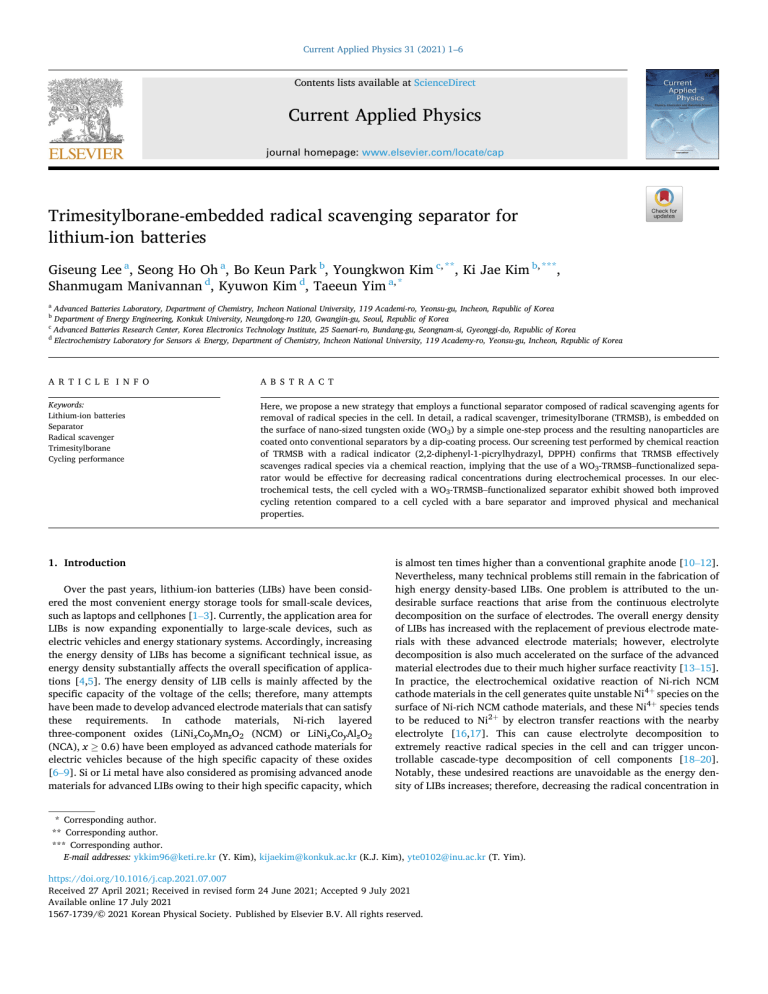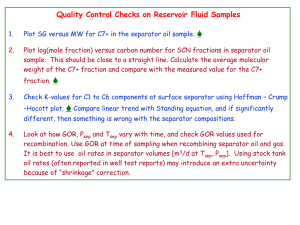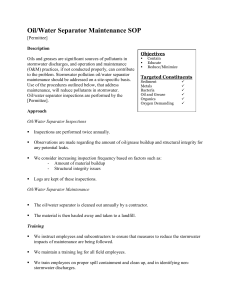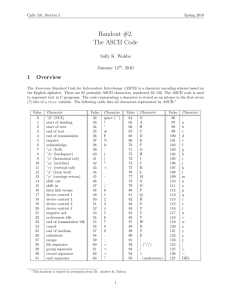
Current Applied Physics 31 (2021) 1–6
Contents lists available at ScienceDirect
Current Applied Physics
journal homepage: www.elsevier.com/locate/cap
Trimesitylborane-embedded radical scavenging separator for
lithium-ion batteries
Giseung Lee a, Seong Ho Oh a, Bo Keun Park b, Youngkwon Kim c, **, Ki Jae Kim b, ***,
Shanmugam Manivannan d, Kyuwon Kim d, Taeeun Yim a, *
a
Advanced Batteries Laboratory, Department of Chemistry, Incheon National University, 119 Academi-ro, Yeonsu-gu, Incheon, Republic of Korea
Department of Energy Engineering, Konkuk University, Neungdong-ro 120, Gwangjin-gu, Seoul, Republic of Korea
Advanced Batteries Research Center, Korea Electronics Technology Institute, 25 Saenari-ro, Bundang-gu, Seongnam-si, Gyeonggi-do, Republic of Korea
d
Electrochemistry Laboratory for Sensors & Energy, Department of Chemistry, Incheon National University, 119 Academy-ro, Yeonsu-gu, Incheon, Republic of Korea
b
c
A R T I C L E I N F O
A B S T R A C T
Keywords:
Lithium-ion batteries
Separator
Radical scavenger
Trimesitylborane
Cycling performance
Here, we propose a new strategy that employs a functional separator composed of radical scavenging agents for
removal of radical species in the cell. In detail, a radical scavenger, trimesitylborane (TRMSB), is embedded on
the surface of nano-sized tungsten oxide (WO3) by a simple one-step process and the resulting nanoparticles are
coated onto conventional separators by a dip-coating process. Our screening test performed by chemical reaction
of TRMSB with a radical indicator (2,2-diphenyl-1-picrylhydrazyl, DPPH) confirms that TRMSB effectively
scavenges radical species via a chemical reaction, implying that the use of a WO3-TRMSB–functionalized sepa­
rator would be effective for decreasing radical concentrations during electrochemical processes. In our elec­
trochemical tests, the cell cycled with a WO3-TRMSB–functionalized separator exhibit showed both improved
cycling retention compared to a cell cycled with a bare separator and improved physical and mechanical
properties.
1. Introduction
is almost ten times higher than a conventional graphite anode [10–12].
Nevertheless, many technical problems still remain in the fabrication of
high energy density-based LIBs. One problem is attributed to the un­
desirable surface reactions that arise from the continuous electrolyte
decomposition on the surface of electrodes. The overall energy density
of LIBs has increased with the replacement of previous electrode mate­
rials with these advanced electrode materials; however, electrolyte
decomposition is also much accelerated on the surface of the advanced
material electrodes due to their much higher surface reactivity [13–15].
In practice, the electrochemical oxidative reaction of Ni-rich NCM
cathode materials in the cell generates quite unstable Ni4+ species on the
surface of Ni-rich NCM cathode materials, and these Ni4+ species tends
to be reduced to Ni2+ by electron transfer reactions with the nearby
electrolyte [16,17]. This can cause electrolyte decomposition to
extremely reactive radical species in the cell and can trigger uncon­
trollable cascade-type decomposition of cell components [18–20].
Notably, these undesired reactions are unavoidable as the energy den­
sity of LIBs increases; therefore, decreasing the radical concentration in
Over the past years, lithium-ion batteries (LIBs) have been consid­
ered the most convenient energy storage tools for small-scale devices,
such as laptops and cellphones [1–3]. Currently, the application area for
LIBs is now expanding exponentially to large-scale devices, such as
electric vehicles and energy stationary systems. Accordingly, increasing
the energy density of LIBs has become a significant technical issue, as
energy density substantially affects the overall specification of applica­
tions [4,5]. The energy density of LIB cells is mainly affected by the
specific capacity of the voltage of the cells; therefore, many attempts
have been made to develop advanced electrode materials that can satisfy
these requirements. In cathode materials, Ni-rich layered
three-component oxides (LiNixCoyMnzO2 (NCM) or LiNixCoyAlzO2
(NCA), x ≥ 0.6) have been employed as advanced cathode materials for
electric vehicles because of the high specific capacity of these oxides
[6–9]. Si or Li metal have also considered as promising advanced anode
materials for advanced LIBs owing to their high specific capacity, which
* Corresponding author.
** Corresponding author.
*** Corresponding author.
E-mail addresses: ykkim96@keti.re.kr (Y. Kim), kijaekim@konkuk.ac.kr (K.J. Kim), yte0102@inu.ac.kr (T. Yim).
https://doi.org/10.1016/j.cap.2021.07.007
Received 27 April 2021; Received in revised form 24 June 2021; Accepted 9 July 2021
Available online 17 July 2021
1567-1739/© 2021 Korean Physical Society. Published by Elsevier B.V. All rights reserved.
G. Lee et al.
Current Applied Physics 31 (2021) 1–6
Fig. 1. (a) Scheme of manufacturing method and function of WO3-TRMSB-embedded PE, (b) SEM/EDS of WO3-TRMSB-embedded PE separator surface morphology,
(c) Fourier transform infrared (FT-IR) spectra of PE (black), WO3-TRMSB-embedded PE (red). (For interpretation of the references to color in this figure legend, the
reader is referred to the Web version of this article.)
2
G. Lee et al.
Current Applied Physics 31 (2021) 1–6
Fig. 2. (a) Electrolyte uptake result and contact angle (inset), (b) Ionic conductivity, (c) gurley number, (d) tensile strength of PE (black), WO3-TRMSB-embedded PE
(red) separator. (For interpretation of the references to color in this figure legend, the reader is referred to the Web version of this article.)
the cell is necessary to increase the safety of the LIBs.
In this work, we propose a dually functionalized radical scavenging
responsive separator for improved electrochemical performance of LIBs
(Fig. 1a). Our approach is based on embedding an effective radical
scavenger onto the separator; however, the commonly used poly
(ethylene) (PE) separator presents a serious limitation for the intro­
duction of a functional radical scavenger because the PE separator is
composed of extremely stable aliphatic carbon-hydrogen components
[21–23]. Therefore, we use tungsten oxide (WO3) as an interlayer for
embedding a radical scavenging agent onto the PE separator because the
hydroxyl group (OH) on the WO3 surface can chemically bind with the
radical scavenger trimesitylborane (TRMSB). We anticipated that once
TRMSB was anchored on WO3, the WO3-TRMSB composites could be
easily coated onto the PE separator by a simple dip-coating process for
prompt scavenging of nearby radical species formed by electrolyte
decomposition. The WO3-TRMSB-functionalized PE separator would be
effective at decreasing radical concentrations in the cell and would lead
to improved cycling performance of the cell. Based on these consider­
ations, a WO3-TRMSB-functionalized PE separator is prepared and its
physicochemical and electrochemical properties are systematically
explored using Ni-rich NCM cathode materials.
filtration, dried for 3 h, and then dispersed in an acetone solution of
PVdF-HFP (Aldrich) and sonicated for 5 min. The TRMSB-immobilized
WO3 was then coated onto poly (ethylene) (PE, Celgard) separators by
a dip-coating process.
The radical scavenging performance of TRMSB was screened by
dissolving 0.02 g TRMSB and 0.05 mM DPPH (TCI) in 40.0 mL ethanol
for 1 h at room temperature. The resulting mixture was measured by
UV–Vis spectrometry (KLAB, OPTIZEN POP-V). The surface morphol­
ogies of the WO3-TRMSB–functionalized PE separator were character­
ized by field-emission scanning electron microscopy (FE-SEM/EDS7001 F, JEOL) and the chemical compositions were analyzed by Fourier
transform infrared (FT-IR) spectroscopy (PerkinElmer, Spectrum Two).
The Gurley number of the separators were measured by a Gurley-type
densometer (Toyoseiki) and the mechanical properties were measured
with a tensile-strength machine (JSV H1000, USA) at a tensile speed of
30 mm min− 1. The separator contact angles were measured with a
contact angle meter (S.E.O. Co. Ltd, Phoenix-MT) and the separator ionic
conductivities were determined with a Li symmetric cell. The electro­
chemical impedance spectroscopy was acquired with a potentiostat
(WonATech, Zive MP1) at a frequency range of 106–10− 2 Hz and an
amplitude of 10 mV. The separator electrochemical stability was
measured by linear sweep voltammetry (LSV) by a potentiostat
(WonATech, Zive MP1).
The cycling performance was evaluated by preparing the cathode
and anode as follows. The NCM811 cathode was prepare by mixing 1.8 g
NCM811 (L&F materials), 0.1 g carbon conducting agent (Super P), and
0.1 g poly (vinylidene fluoride) (PVdF, Kureha) in 1.5 mL N-methyl­
pyrrolidone (Aldrich). This slurry was casted onto Al foil and dried for
2. Experimental
The WO3-TRMSB-functionalized PE separator was prepared as fol­
lows. WO3 (Rovs) and TRMSB (Aldrich) were dispersed in acetone at a
5:1 wt ratio and mechanically agitated for 12 h. After completion of the
condensation reaction, the TRMSB-immobilized WO3 was collected by
3
G. Lee et al.
Current Applied Physics 31 (2021) 1–6
12 h at 120 ◦ C in a vacuum oven. The graphite anode was prepared from
a slurry of 1.92 g graphite (PoscoChemtech), 0.02 g carbon conducting
agent (Super P), 0.02 g carboxymethyl cellulose (CMC, Cellogen, DKS),
and 0.04 g styrene− butadiene rubber (SBR, Zeon, BM 400 B). The slurry
was coated onto Cu foil and dried for 11 h at 110 ◦ C in vacuum oven. The
cells were assembled as a NCM811 cathode, graphite anode, a separator,
and an electrolyte consisting of ethylene carbonate (EC):ethyl methyl
carbonate (EMC) (1:2, vol%) + 1.0 M LiPF6 (Donghwa Electrolyte). The
cells were charged and discharged from 3.0 V to 4.2 V at a 0.1 C current
rate for two cycles and at 1.0 C for 300 cycles at room temperature.
3. Results and discussion
Fig. 1a presents the molecular structure of the radical scavenging
agent (TRMSB) and a brief scheme for embedding it onto the PE sepa­
rator by a dip-coating process. However, we also noted that direct
embedding of TRMSB onto the PE separator is quite difficult owing to
the extremely stable nature of the PE separator. For this reason, we first
embedded TRMSB onto WO3 by the condensation reaction and subse­
quently dip-coated the WO3-TRMSB onto the PE separator. Fig. 1b shows
the surface morphologies of the WO3-TRMSB–embedded PE separator.
Compared to a bare PE separator, the surface of the dip-coated separator
seems to be well coated with the WO3-TRMSB composites without se­
vere pore clogging. The EDS result confirmed the presence of the core
elements W, B and F, indicating effective coating with WO3-TRMSB.
Prior to the dip-coating process, the thickness of the bare PE separator
was 14 μm; however, the overall thickness of the WO3-TRMSB–embed­
ded PE separator was increased to 26 μm. It means that, on average,
WO3-TRMSB layers of 12 μm thickness are formed on the surface of the
bare PE separator by our process. Additional FT-IR analyses also support
the successful formation of WO3-TRMSB layers on the surface of the PE
– C trans­
separator (Fig. 1c). Compared to a bare PE separator, the C–
− 1
mittance peaks were found at 1606 cm , implying that the TRMSB
material is well bound onto the bare PE separator.
Fig. 2 shows the physical properties of the WO3-TRMSB–embedded
PE separator. The contact angle analyses (inset of Fig. 2a) indicated a
38.8◦ contact angle when the conventional electrolyte is dropped onto
the PE separator, but a decreased angle of 11.7◦ for the WO3TRMSB–functionalized PE separator, indicating an improved wettability
of the WO3-TRMSB–embedded PE separator due to the coating of hy­
drophilic WO3 and TRMSB materials onto the hydrophobic PE separator.
This finding matches well with the electrolyte uptake results (Fig. 2a), as
the bare PE separator shows a 201.1% electrolyte uptake performance
after 1 h. By contrast, the electrolyte uptake performance of the WO3TRMSB–functionalized PE separator is markedly improved, to 467.1%,
indicating that embedding WO3-TRMSB composites onto PE separator is
beneficial for the physical interaction with a conventional electrolyte.
Therefore, the ionic conductivity of the WO3-TRMSB–functionalized PE
separator is clearly improved compared to the bare PE separator (0.57
mS cm− 1 vs. 1.03 mS cm− 1) (Fig. 2b). The air permeability of the WO3TRMSB–embedded PE separator was decreased compared to the bare PE
separator (224.5 s vs. 365.1 s) as new WO3-TRMSB layers formed on the
surface of the PE separator (Fig. 2c); however, this permeability can still
be acceptable for use in LIBs based on the improved wettability [24,25].
As embedding nanosized WO3 particles on the surface of the PE sepa­
rator, mechanical properties of the WO3-TRMSB–embedded PE sepa­
rator seem to be improved (Fig. 2d): ultimate strength of the PE
separator was 152.3 MPa, however, the WO3-TRMSB–embedded PE
separator exhibits 160.9 MPa of ultimate strength, which indicates
mechanical properties of separator are improved.
It is anticipated that the centered boron atom has an empty p-orbital;
therefore, it readily receives nearby electrons to satisfy the octet rule
[26,27]. Consequently, radical species remaining in the cell can be easily
scavenged by chemical reaction with TRMSB. Therefore, the inclusion of
TRMSB allows the rapid formation of a boron-radical bond in the cell via
the chemical scavenging reaction. In this regard, we further clarified the
Fig. 3. (a) Before and after reaction image of DPPH solution (left), DPPH +
TRMSB solution (right), (b) After reaction UV–Vis spectroscopy result of DPPH
(violet) and DPPH + TRMSB (green). (For interpretation of the references to
color in this figure legend, the reader is referred to the Web version of
this article.)
radical scavenging performance of TRMSB with an additional screening
test, as shown in Fig. 3. DPPH (2,2-diphenyl-1-picrylhydrazyl) is
employed as an indicating material because the reaction of the DPPH
radical with TRMSB results in a rapid color change (from purple to
yellow) as the conjugation state of DPPH is also changed [28,29]. In our
case, the color of DPPH + TRMSB solution changed from purple to
yellow, indicating the likely scavenging of the radical species of DPPH
by a chemical reaction with TRMSB. The UV–vis spectra showed a
maximum wavelength of DPPH of 517 nm; however, this was shifted to
490 nm after completion of the chemical reaction, confirming that
TRMSB can effectively scavenge radical species in the cell via a chemical
reaction.
Based on these results, we evaluated the electrochemical perfor­
mance of the WO3-TRMSB–functionalized PE separator, as shown in
Fig. 4. The LSV results (Fig. 4a) revealed that the WO3-TRMSB-func­
tionalized PE separator had identical profiles to those of the bare PE
separator under anodic polarization. This indicates that the oxidation
stability is not changed when WO3-TRMSB composites are coated onto a
PE separator. For cathodic polarization (Fig. 4b), electrochemical
reduction of TRMSB was measured around at 0.63 V (vs. Li/Li+), which
can make solid electrolyte interphases (SEI) layers on the surface of
graphite anode[30,31]. In full-cell cycling performances, the voltage
profiles indicated similar electrochemical behaviors in a graph­
ite/NCM811 full-cell (Fig. 4c). The cells cycled with bare and
WO3-TRMSB–functionalized PE separators revealed identical voltage
profiles without side reactions at the initial cycle. The cycling tests
(Fig. 4d) showed that the cell cycled with the bare PE separator expe­
rienced continuous fading in the cycling retention, with 77.9% of the
capacity loss observed at the end of cycling. By contrast, the cell cycled
with the WO3-TRMSB–functionalized PE separator exhibits improved
cycling retention (84.5%) after 300 cycles. Note that the continuous
fading in the cycling retention is commonly observed in the cell with the
4
G. Lee et al.
Current Applied Physics 31 (2021) 1–6
Fig. 4. Linear sweep voltammetry (LSV) result of (a) 3.0–4.5 V (vs. Li/Li+), (b) 3.0–0.0 V (vs. Li/Li+), (c) 1.0 C 1st cycle Voltage profile (d) NCM811/graphite fullcell electrochemical performance of PE (black) and WO3-TRMSB-embedded PE (red). (For interpretation of the references to color in this figure legend, the reader is
referred to the Web version of this article.)
NCM811 cathode because the relatively reactive Ni4+ species (charged
product) accelerates electrolyte decomposition during the electro­
chemical charging process [32,33]. Electrolyte decomposition in the cell
causes the formation of many different reactive radical species in the cell
and the subsequent chemical/electrochemical reactions accelerate the
decrease in cycling retention in the cell [34,35]. This means that once
the WO3-TRMSB–functionalized PE separator effectively scavenges the
radical species remaining in the cell via chemical reaction, it markedly
reduces the concentration of reactive radical species in the cell, thereby
leading to improvement of the cycling retention.
believe that this approach would be an effective way to improve the
cycling performance of LIBs without any serious trade-off effects in the
cell.
4. Conclusions
Acknowledgements
The electrochemical performance of LIBs is improved by developing
a radical scavenging separator functionalized with WO3 and TRMSB.
The radical scavenging agent, TRMSB, is first embedded onto the surface
of WO3 via a simple condensation reaction. This is followed by a dipcoating process to form the WO3-TRMSB–functionalized PE separator.
An ex situ screening test using the chemical reaction between TRMSB,
AIBN, and a radical indicator (DPPH) confirms that TRMSB effectively
removes radical species by a chemical reaction, thereby implying that
the WO3-TRMSB–functionalized PE separator can increase the chemical
stability of the cell during the electrochemical reaction. In practice, the
cell cycled with the WO3-TRMSB–functionalized separator exhibits
improved cycling retention compared to a cell cycled with a bare
separator because the WO3-TRMSB–functionalized separator suppresses
the continuous electrolyte decomposition by terminating the reactions
of reactive radical species during the electrochemical process. We
This work was supported by the Post-Doctoral Research Program
(2018) in the Incheon National University.
Declaration of competing interest
The authors declare that they have no known competing financial
interests or personal relationships that could have appeared to influence
the work reported in this paper.
References
[1] K. Liu, Y. Liu, D. Lin, A. Pei, Y. Cui, Materials for lithium-ion battery safety, Sci.
Adv. 4 (6) (2018), eaas9820.
[2] T. Jeon, S. Lee, S.C. Jung, Boron-, nitrogen-, aluminum-, and phosphorus-doped
graphite electrodes for non-lithium ion batteries, Curr. Appl. Phys. 20 (8) (2020)
988–993.
[3] M. Li, J. Lu, Cobalt in lithium-ion batteries, Science 367 (6481) (2020) 979–980.
[4] A. Manthiram, An outlook on lithium ion battery technology, ACS Cent. Sci. 3 (10)
(2017) 1063–1069.
[5] Y.-K. Han, Y. Moon, K. Lee, Y.S. Huh, Computational screening of lactam molecules
as solid electrolyte interphase forming additives in lithium-ion batteries, Curr.
Appl. Phys. 14 (6) (2014) 897–900.
[6] J.B. Goodenough, Y. Kim, Challenges for rechargeable Li batteries, Chem. Mater.
22 (3) (2010) 587–603.
5
G. Lee et al.
Current Applied Physics 31 (2021) 1–6
[7] Y. Li, X. Liu, L. Wang, X. Feng, D. Ren, Y. Wu, G. Xu, L. Lu, J. Hou, W. Zhang,
Thermal runaway mechanism of lithium-ion battery with LiNi0.8Mn0.1Co0.1O2
cathode materials, Nanomater. Energy (2021) 105878.
[8] F. Schipper, E.M. Erickson, C. Erk, J.-Y. Shin, F.F. Chesneau, D. Aurbach, Recent
advances and remaining challenges for lithium ion battery cathodes,
J. Electrochem. Soc. 164 (1) (2016) A6220.
[9] Y.-k. Ahn, Y.N. Jo, W. Cho, J.-S. Yu, K.J. Kim, Mechanism of capacity fading in the
LiNi0.8Co0.1Mn0.1O2 cathode material for lithium-ion batteries, Energies 12 (9)
(2019) 1638.
[10] I.H. Son, J.H. Park, S. Kwon, S. Park, M.H. Rümmeli, A. Bachmatiuk, H.J. Song,
J. Ku, J.W. Choi, J.-m. Choi, Silicon carbide-free graphene growth on silicon for
lithium-ion battery with high volumetric energy density, Nat. Commun. 6 (1)
(2015) 1–8.
[11] X. Li, M. Gu, S. Hu, R. Kennard, P. Yan, X. Chen, C. Wang, M.J. Sailor, J.-G. Zhang,
J. Liu, Mesoporous silicon sponge as an anti-pulverization structure for highperformance lithium-ion battery anodes, Nat. Commun. 5 (1) (2014) 1–7.
[12] C.-Z. Zhao, P.-Y. Chen, R. Zhang, X. Chen, B.-Q. Li, X.-Q. Zhang, X.-B. Cheng,
Q. Zhang, An ion redistributor for dendrite-free lithium metal anodes, Sci. Adv. 4
(11) (2018), eaat3446.
[13] D.-S. Lee, Y.-H. Choi, H.-D. Jeong, Effect of electron beam irradiation on the
capacity fading of hydride-terminated silicon nanocrystal based anode materials
for lithium ion batteries, J. Ind. Eng. Chem. 53 (2017) 82–92.
[14] W. Liu, P. Oh, X. Liu, M.J. Lee, W. Cho, S. Chae, Y. Kim, J. Cho, Nickel-rich layered
lithium transition-metal oxide for high-energy lithium-ion batteries, Angew. Chem.
Int. Ed. 54 (15) (2015) 4440–4457.
[15] Z. Chen, D. Chao, J. Lin, Z. Shen, Recent progress in surface coating of layered
LiNixCoyMnzO2 for lithium-ion batteries, Mater. Res. Bull. 96 (2017) 491–502.
[16] S. Yang, Q. Fan, Z. Shi, L. Liu, J. Liu, X. Ke, J. Liu, C. Hong, Y. Yang, Z. Guo,
Superior stability secured by a four-phase cathode electrolyte interface on a Ni-rich
cathode for lithium ion batteries, ACS Appl. Mater. Interfaces 11 (40) (2019)
36742–36750.
[17] H.-H. Ryu, K.-J. Park, C.S. Yoon, Y.-K. Sun, Capacity fading of Ni-rich Li
[NixCoyMn1–x–y]O2 (0.6≤ x≤ 0.95) cathodes for high-energy-density lithium-ion
batteries: bulk or surface degradation? Chem. Mater. 30 (3) (2018) 1155–1163.
[18] L. Xing, W. Li, C. Wang, F. Gu, M. Xu, C. Tan, J. Yi, Theoretical investigations on
oxidative stability of solvents and oxidative decomposition mechanism of ethylene
carbonate for lithium ion battery use, J. Phys. Chem. B 113 (52) (2009)
16596–16602.
[19] B.L. Rinkel, D.S. Hall, I. Temprano, C.P. Grey, Electrolyte oxidation pathways in
lithium-ion batteries, J. Am. Chem. Soc. 142 (35) (2020) 15058–15074.
[20] K. Ushirogata, K. Sodeyama, Y. Okuno, Y. Tateyama, Additive effect on reductive
decomposition and binding of carbonate-based solvent toward solid electrolyte
interphase formation in lithium-ion battery, J. Am. Chem. Soc. 135 (32) (2013)
11967–11974.
[21] Y. Deng, X. Song, Z. Ma, X. Zhang, D. Shu, J. Nan, Al2O3/PVdF-HFP-CMC/PE
separator prepared using aqueous slurry and post-hot-pressing method for polymer
lithium-ion batteries with enhanced safety, Electrochim. Acta 212 (2016) 416–425.
[22] W. Xu, Z. Wang, L. Shi, Y. Ma, S. Yuan, L. Sun, Y. Zhao, M. Zhang, J. Zhu, Layer-bylayer deposition of organic–inorganic hybrid multilayer on microporous
polyethylene separator to enhance the electrochemical performance of lithium-ion
battery, ACS Appl. Mater. Interfaces 7 (37) (2015) 20678–20686.
[23] W. Chen, L. Shi, Z. Wang, J. Zhu, H. Yang, X. Mao, M. Chi, L. Sun, S. Yuan, Porous
cellulose diacetate-SiO2 composite coating on polyethylene separator for highperformance lithium-ion battery, Carbohydr. Polym. 147 (2016) 517–524.
[24] Y. Song, L. Sheng, L. Wang, H. Xu, X. He, From separator to membrane: separators
can function more in lithium ion batteries, Electrochem. Commun. 124 (2021)
106948.
[25] J.-R. Lee, J.-H. Won, J.H. Kim, K.J. Kim, S.-Y. Lee, Evaporation-induced selfassembled silica colloidal particle-assisted nanoporous structural evolution of poly
(ethylene terephthalate) nonwoven composite separators for high-safety/high-rate
lithium-ion batteries, J. Power Sources 216 (2012) 42–47.
[26] B. Wang, Y. Li, R. Ganguly, R.D. Webster, R. Kinjo, A crystalline diazadiborinine
radical cation and its boron-centered radical reactivity, Angew. Chem. Int. Ed. 57
(26) (2018) 7826–7829.
[27] P. Renaud, A. Beauseigneur, A. Brecht-Forster, B. Becattini, V. Darmency,
S. Kandhasamy, F. Montermini, C. Ollivier, P. Panchaud, D. Pozzi, Boron: a key
element in radical reactions, Pure Appl. Chem. 79 (2) (2007) 223–233.
[28] Y. Bao, Y. Qu, J. Li, Y. Li, X. Ren, K.G. Maffucci, R. Li, Z. Wang, R. Zeng, In vitro
and in vivo antioxidant activities of the flowers and leaves from Paeonia rockii and
identification of their antioxidant constituents by UHPLC-ESI-HRMSn via precolumn DPPH reaction, Molecules 23 (2) (2018) 392.
[29] D. Goujot, M.-E. Cuvelier, P. Soto, F. Courtois, A stoichio-kinetic model for a
DPPH∙-ferulic acid reaction, Talanta 196 (2019) 284–292.
[30] H. Lee, S. Choi, S. Choi, H.-J. Kim, Y. Choi, S. Yoon, J.-J. Cho, SEI layer-forming
additives for LiNi0.5Mn1.5O4/graphite 5 V Li-ion batteries, Electrochem. Commun.
9 (4) (2007) 801–806.
[31] H.M. Jung, S.-H. Park, J. Jeon, Y. Choi, S. Yoon, J.-J. Cho, S. Oh, S. Kang, Y.K. Han, H. Lee, Fluoropropane sultone as an SEI-forming additive that outperforms
vinylene carbonate, J. Mater. Chem. 1 (38) (2013) 11975–11981.
[32] L. Liang, W. Zhang, F. Zhao, D.K. Denis, F.U. Zaman, L. Hou, C. Yuan, Surface/
Interface structure degradation of Ni-rich layered oxide cathodes toward lithiumion batteries: fundamental mechanisms and remedying strategies, Adv. Mater.
Interfaces 7 (3) (2020) 1901749.
[33] Y. Han, X. Shan, G. Zhu, Y. Wang, Q. Qu, H. Zheng, Hierarchically assembled
LiNi0.8Co0.1Mn0.1O2 secondary particles with high exposure of {010} plane
synthesized via co-precipitation method, Electrochim. Acta 329 (2020) 135057.
[34] Y. Ma, K. Chen, J. Ma, G. Xu, S. Dong, B. Chen, J. Li, Z. Chen, X. Zhou, G. Cui,
A biomass based free radical scavenger binder endowing a compatible cathode
interface for 5 V lithium-ion batteries, Energy Environ. Sci. 12 (1) (2019) 273–280.
[35] X. Wei, W. Xu, J. Huang, L. Zhang, E. Walter, C. Lawrence, M. Vijayakumar, W.
A. Henderson, T. Liu, L. Cosimbescu, Radical compatibility with nonaqueous
electrolytes and its impact on an all-organic redox flow battery, Angew. Chem. Int.
Ed. 54 (30) (2015) 8684–8687.
6




